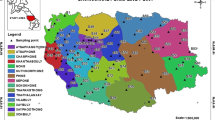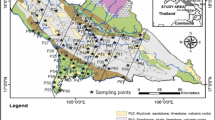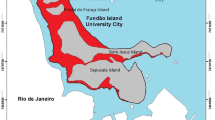Abstract
The goal of the present work is to determine the specific activity of terrestrial thorium, uranium and potassium in Uzhgorod city and to predict the values of specific activity over the whole area of Uzhgorod city. The following values for the average specific activity in 2006–2012 were found for different radioisotopes from the surface soils (in Bq kg−1): 40K = 304.0 ± 12.3; 232Th = 24.2 ± 2.1; 238U = 19.2 ± 1.2. The average value of the absorbed dose was equal to 36.3 ± 2.3 nGy h−1. The average value of the external hazard index was equal to 0.22. The average annual effective dose of natural radionuclides was equal to 4.5 ± 0.3 10−5 Sv.
Similar content being viewed by others
Explore related subjects
Discover the latest articles, news and stories from top researchers in related subjects.Avoid common mistakes on your manuscript.
Introduction
The research into the background of natural radioactivity worldwide is aimed at cosmic rays and terrestrial radiation as presented in UNSCEAR [1]. Natural background radioactivity depends on geological and geographical conditions and is randomly distributed in soil in different regions of the world [2, 3].
Radionuclides from the 238U and 232Th decay series and 40K are widely spread in the environment of the Earth’s crust which generates a significant amount of background radiation exposure of the world population. Measurement of these nuclides allows to determine the radioactive concentrations dependence on soil types, the external sources of radiation to humans and the background baseline of the natural radioactivity. The estimation of the total radiation dose for the world population has shown that about 96 % of this dose is from natural sources [4, 5].
Uzhgorod city is located in the western Ukraine, at the border with Slovakia and near the border with Hungary. The city is located at the foothills of the Carpathian Mountains in the east and in the west of the Danube lowland. The river Uzh which flows through Uzhgorod, starts from the western slopes of the Carpathians, its basin area is around 2000 km2. Podzolic and gray forest soil types prevail in the city.
The systematized long-term research in the urban areas of the Ukrainian Carpathians can be used as a reference for the ecological certification and classification of Uzhgorod surface soils, and also helps to study the geology of the area [6, 7]. Determination of the concentration of radionuclides in surface soil is essential for assessment of radiological risk to human health [8].
The present study is initiated to determine the contribution of the natural radionuclides 238U, 232Th, and 40K in soil from 37 sampling locations in Uzhgorod within the period of 7 years using the gamma-ray spectrometry to compute activity and absorbed gamma dose rate in the air due to the presence of the terrestrial radionuclides in soil samples and also predict the values of specific activity over the whole area of Uzhgorod city.
Materials and methods
The samples from the surface soils were collected from 37 points (Fig. 1) in the Uzhgorod area during 2006–2012 years from the same sampling point every year. The global positioning and navigation system (GPS) was used to obtain information about the geographical positions of the sampling locations (Table 1).
Each sample was obtained from the 3–5 sub-samples collected from the 0–10 cm depth and merged in situ.
All samples were dried at the temperature of 60 °C during 48 h, sieved through the 2 mm strainer, weighted and placed/stored in the cylindrical polyethylene containers (0.5 dm3 volume) for the further measurements.
The measurements were carried out using high resolution gamma-spectrometry technique with the Ge(Li) detector DGDK-100 V. The detector was placed inside the massive 15 cm thick lead shield with the inner aluminum (3 mm thick), copper (8 mm thick) and cadmium (1 mm thick) sheets in order to reduce background radiation. The detector has an average gamma-ray photo-peak resolution of 3.5 keV for the 1332.5 keV (60Co) line. The bulk standard γ-sources (40K, 137Cs, 152Eu, 232Th) were used for the detector efficiency calibration.
The absolute efficiency of the detector is related to energy by the expression [9]:
where ε(Eγ) is the γ-spectrometric detector efficiency, Eγ is the γ-quanta energy (keV), E 0 = 1 keV and E a = 1.8442 keV.
The minimum detectable activity (MDA) of the system was estimated with the 95 % confidence level using the following formula [10, 11]:
where B is the background counts, t is the counting time (s), γ is the gamma emission probability, ε is the absolute detector efficiency at the particular gamma energy and w is the sample weight (kg).
The MDA with the 95 % confidence level (for the 650 g soil sample and the 20,000 s counting time) for the important radionuclides such as 238U (226Ra), 232Th, and 40K are 6.38, 9.23, 36.85 Bq kg−1, respectively.
All samples were measured with an identical geometry. The measurement time was equal to 20,000 s for each sample.
The typical gamma spectra of the sample and the background are shown in Fig. 2.
When the measurements were ongoing the spectrometer was controlled for the following parameters: channel drift, energy resolution and efficiency. The variation of these parameters did not exceed 1 % during the measurements.
The activity concentrations of 238U (226Ra) were calculated using the weighted average values of the γ-ray lines of 214Bi.
In the case of the 232Th series, the activities were calculated by using the gamma-ray lines of 228Ac and 208Tl.
The specific activity (Bq kg−1) of the samples was calculated using the following formula:
where C is the net peak area, t is the counting time (s), γ is the gamma emission probability, ε is the absolute efficiency of the detector at the particular gamma energy and w is the dry weight of the sample (kg).
The statistic error of the measured specific activity is in the range of 8–12 %.
The specific activity values were used in order to determine the absorbed doses.
The total air absorbed dose rate (nGy h−1) at 1 m above the ground level due to the specific activities of natural radionuclides was calculated using the eq [1]:
where A U , A Th and A K are the specific activities [Bq kg−1] of the 238U, 232Th, and 40K radioisotopes respectively.
The values of the external hazard index of natural radionuclides were determined by the following formula:
The values of the external hazard index are usually less than 1, but in case of the artificial (technogenic) pollution they exceed 1 [1].
The level of the annual effective dose of natural radionuclides was determined by the formula [1]:
where D is the absorbed dose [nGy h−1].
Results and discussion
The following values of the average specific activity in 2006–2012 years were detected for different radioisotopes from the surface soils of the Uzhgorod area: 40K = 304.0 ± 12.3 Bq kg−1, 232Th (228Ac) = 24.2 ± 2.1 Bq kg−1, 238U (214Bi) = 19.2 ± 1.2 Bq kg−1 (see Table 2).
The average values of the specific activity and dose rate for 40K, 232Th, and 238U of the surface soil samples in 2006–2012 are shown in Figs. 3, 4 and 5.
The values of the specific activity of the natural 40K radionuclide and the members of the 232Th and 238U series were used for constructing the experimental GIS maps (this geostatistical technique was applied to interpolate the values of the specific activity of the terrestrial radionuclide 40K and the members of the 232Th and 238U series in the sampling points).
The geographic information mapping system may be determined as production of maps by using specific activity and computer program that calculates the interpolation values at the locations of the area under study [12]. The GIS maps of the average specific activity of the natural 226Ra, 232Th and 40K radionuclides in the surface layers of the Uzhgorod soils were presented. For the GIS maps creation we have used the Quantum GIS software product, which is an open-source GIS system freely available on the internet for the general public.
The GIS maps of the specific activity for 40K, 232Th, and 238U of the surface soil samples are shown in Figs. 6,7 and 8.
The concentration of the radionuclides from the 238U and 232Th series and 40K in soil of the area under study depends on the geology of the area and the surrounding mountains where the material was eroded and transported by rain water into the basin of the river Uzh. Distribution of 40K in surface soil of Uzhgorod in relation to radionuclides 238U and 232Th series may be explained by the weathering in crystalline rocks of the Carpathians Mountains, potassium is readily dissolved therefore may have been removed from the rocks [13].
Due to the natural processes of soil formation, each type of soil is characterized by the particular distribution of natural radionuclides in the surface layer [14]. Podzolic soil types have lower specific activity of natural radionuclides (40K = 300 Bq kg−1, 232Th = 20 Bq kg−1, 238U = 18 Bq kg−1) and gray forest soil types have higher specific activity of natural radionuclides (40K = 350 Bq kg−1, 232Th = 27 Bq kg−1, 238U = 21 Bq kg−1) in Uzhgorod.
The average values of the absorbed dose for the natural radionuclides 40K, 232Th, 238U are shown in Fig. 9. The average value of the absorbed dose is 36.3 ± 2.3 nGy h−1.
The values of the annual effective dose from natural radionuclides measured in Uzhgorod in 2006–2012 are shown in Table 3. The average annual effective dose of the natural radionuclides is 4.5 ± 0.3 10−5 Sv.
The average value of the external hazard index of the natural radionuclides for period 2006–2012 was calculated to be 0.22 that testifies to the absence of technogenic (artificial) pollution.
The values of the absorbed dose, external hazard index and annual effective dose for natural radionuclides for the neighboring countries (Table 4) show that they are higher than those for Uzhgorod.
Conclusions
The results confirm that the average values of 238U (19.2 ± 1.2 Bq kg−1) and 232Th (24.2 ± 2.1 Bq kg−1) are slightly less than the world average values of 238U (35 Bq kg−1) and 232Th (30 Bq kg−1). The present 40K average activity (304.0 ± 12.3 Bq kg−1) is lower than the world average value (400 Bq kg−1) [1]. Consequently, these values can be used as a reference for ecological certification and classification of Uzhgorod surface soils.
The present average gamma dose rate in the air is 36.3 ± 2.3 nGy h−1 which does not vary significantly from place to place within the natural background area. The calculated annual effective dose with the average value (4.5 ± 0.3 10−5 Sv) is lower than the world average value (6.9 l0−5 Sv) [1].
Geostatistical technique was applied to interpolate the values of the specific activity of the terrestrial radionuclide 40K and the members of the 232Th and 238U series in the sampling points.
References
UNSCEAR (2000) Sources and effects of ionizing radiation, vol 1, Report to the general assembly, with scientific annexes. United Nations Scientific Committee on effects of atomic radiation. United Nations Publication, New York
Baldık R, Aytekin H, Erer M (2011) Radioactivity measurements and radiation dose assessments due to natural radiation in Karabuk (Turkey). J Radioanal Nucl Chem 289:297–302
Rahman SU, Matiullah Malik F et al (2011) Measurement of naturally occurring/fallout radioactive elements and assessment of annual effective dose in soil samples collected from four districts of the Punjab Province, Pakistan. J Radioanal Nucl Chem 287:647–655
Chougankar MP, Eappen KP, Ramachandran TV et al (2004) Profiles of doses to the population living in the high background radiation areas in Kerala, India. J Environ Radioact 71:275–297
UNSCEAR (2008) Sources and effects of ionizing radiation, vol. 1, Report to the general assembly, with scientific annexes. United Nations Scientific Committee on effects of atomic radiation. United Nations Publication, New York
IAEA (2008) Chernobyl: looking back to go forward proceedings of an international conference held in Vienna, Vienna, 6–7 Sept 2005
Kashparov V (2006) Assessment of ecological risk caused by the long-living radionuclides in the environment. Ecotoxicology 6:155–164
Hannan MA, Nguyen N, Rivas M (2013) Natural radioactivity and its gamma dose rate in Mission (Texas) soils. J Radioanal Nucl Chem 295:729–736
Potoki IS (2012) Parametric description of the absolute efficiency of semiconductor detectors for measuring of bulk sample activity Uzhgorod. Univ Sci Herald. Ser Phys 31:196–201 (In Ukrainian)
Currie LA (1968) Limits for qualitative detection and quantitative determination. Anal Chem 40(3):586–593
Chinnaesakki S et al (2012) Performance of HPGe gamma spectrometry system for the measurement of low level radioactivity. J Radioanal Nucl Chem 294(1):143–147
Vukasinovic I, Dordevic A, Rajkovic M, Todorovic D, Pavlovic V (2010) Distribution of natural radionuclides in anthrosol-type soil. Turk J Agric For 34:539–546
Tzortzis M, Tsertos H, Christofides S, Christodoulides G (2003) Gamma-ray measurements of naturally occurring radioactive samples from Cyprus characteristic geological rocks. Radiat Meas 37:221–229
Prokof’ev ON, Smirnov OA (2003) Background levels of the radiation parameters of soil. At Energ 94(4):274–277
Niki I (1996) The radon concentration and adsorbed dose rate in Hungarian dwellings. Radiat Prot Dosim 24:387–389
Mamont-Cieśla K, Jagielak J, Rosiśski Sz W (1995) Indoor radon concentration in Poland. In: Proceedings of Symposium on Radiation Protection in Neighboring Countries in Central Europe, IRPA Regional Congress, Portorož, Slovenia
Iacob O (1996) Exposure from natural radiation sources in Romania. J Prev Med 4:73–82
Acknowledgments
This work was supported by the DPA NAS, Ukraine, Project No. 0109U001502.
Author information
Authors and Affiliations
Corresponding author
Rights and permissions
About this article
Cite this article
Potoki, I., Parlag, O., Maslyuk, V. et al. Long-term monitoring of natural radionuclides in Uzhgorod city, Ukraine. J Radioanal Nucl Chem 306, 249–255 (2015). https://doi.org/10.1007/s10967-015-4065-x
Received:
Published:
Issue Date:
DOI: https://doi.org/10.1007/s10967-015-4065-x













